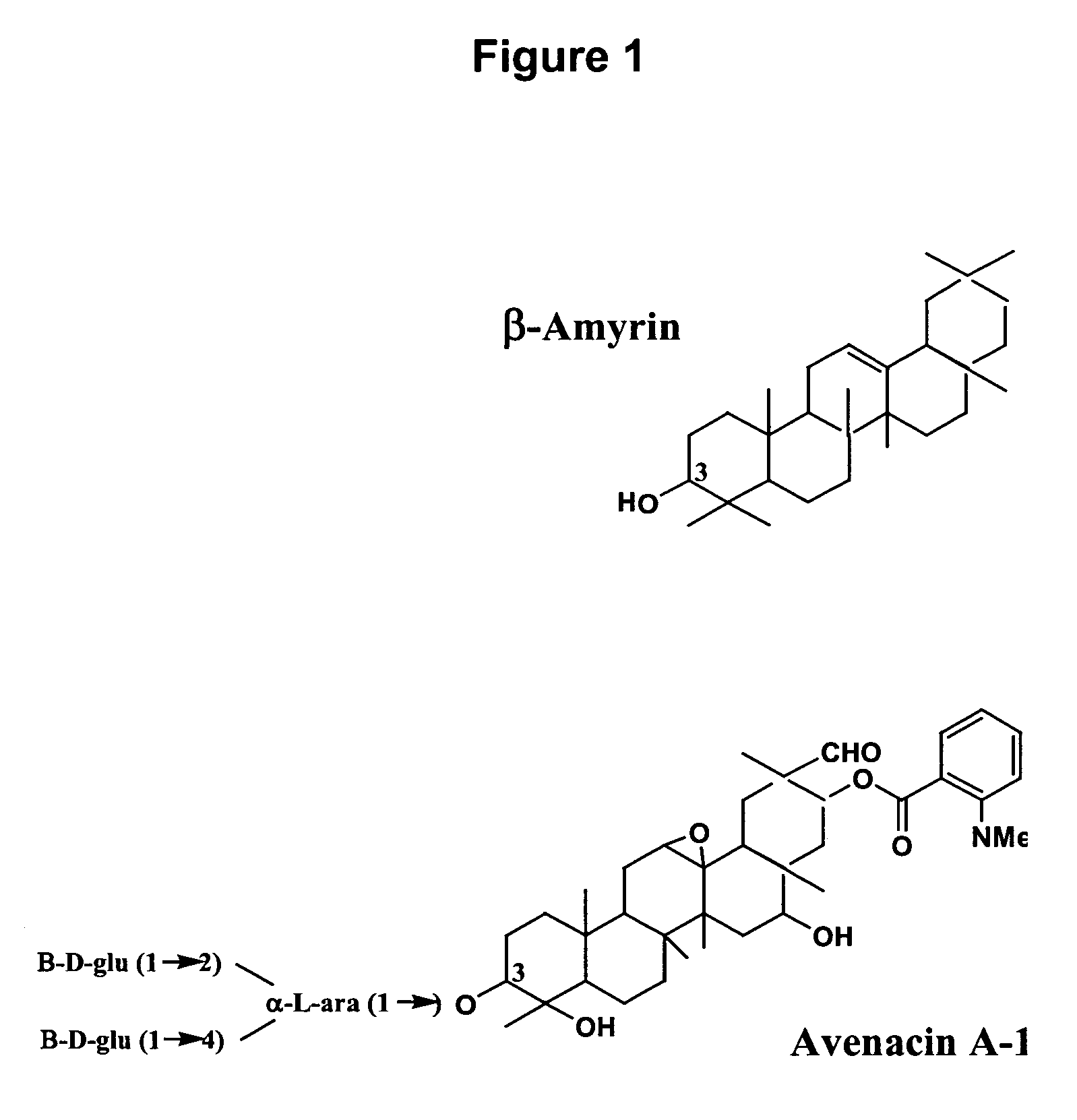Enzymes involved in triterpene synthesis
a triterpene and enzyme technology, applied in the field of plant molecular biology, can solve the problems that the genetic machinery required for the elaboration of this important family of plant secondary metabolites is still largely uncharacterized
- Summary
- Abstract
- Description
- Claims
- Application Information
AI Technical Summary
Benefits of technology
Problems solved by technology
Method used
Image
Examples
example 1
Generation of Mutants and Biochemical Characterization of sad2 Oat Mutants
[0100] Seed of the diploid oat species Avena strigosa were mutagenized with sodium azide and M2 seed from individual M1 plants were germinated and assessed for root fluorescence as a preliminary screen to identify saponin-deficient, or sad, oat mutants. Seedlings not producing avenacins were identified by HPLC and TLC analyses of methanolic root extracts from homozygous M3 seedlings of putative mutants.
Generation of Mutants
[0101] Seed of the diploid oat species Avena strigosa (accession S75 from the Institute of Grasslands and Environmental Research, Aberystwyth, Wales, UK) was mutagenized with sodium azide essentially as described (Rines, H. W., 1985, Env. Exp. Bot., 25:7-17). Briefly, mutagenesis was performed as follows. Seeds were presoaked in an Erlenmeyer flask sealed with a rubber stopper using 0.5 ml water per seed while shaking in an orbital platform shaker at 120 cycles per minute. After presoaki...
example 2
Isolation of the AsCypH1 Genomic and cDNA Fragments
[0113] The genomic polynucleotide fragment encoding the gene affected in sad2 mutants was isolated from A. strigosa accession S75 genomic DNA and from a library prepared from oat as follows.
[0114] The genomic polynucleotide fragment present in A. strigosa accession S75 and affected by the sad2 mutations was identified from a gene cluster identified for avenacin biosynthesis (Qi X. et al., 2004, Proc. Natl. Acad. Sci. U.S.A. 101:8233-8238). First, the hexaploid oat RFLP probe isu441 (Rayapati, P. J., et al., 1994, Theor. Appl. Genet. 89:831-837) previously mapped to the gene cluster for avenacin biosynthesis in diploid oat (Qi X. et al., 2004, Proc. Natl. Acad. Sci. U.S.A. 101:8233-8238) was used. Probe isu441 (which is a cDNA-derived probe) was sequenced by using the ABI PRISM® Big-Dye™ Terminator Cycle Sequencing Ready Reaction Kit (Applied Biosystems) with M13 forward and reverse primers (Qiagen Ltd) and its nucleotide sequence ...
example 3
Cloning and Sequencing of AsCyp51H1 Alleles From Different sad2 Mutants
[0121] The sad2 mutants #791 and #1027 accumulate β-amyrin and so were considered likely to be blocked in a cytochrome P450-mediated step early in the pathway. Previous genetic analysis (Qi X. et al., 2004, Proc. Natl. Acad. Sci. U.S.A. 101:8233-8238) indicated that Sad2 is closely linked to Sad1. This gene, Sad2, has been designated AsbAS1 and has been previously cloned, characterized, and demonstrated to encode β-amyrin synthase, the enzyme that catalyzes the first committed step in avenacin biosynthesis (Haralampidis K. et al., 2001, Proc. Natl. Acad. Sci. U.S.A. 98:13431-13436). Sad2 co-segregates with Sad1 in a population of 2040 F2 individuals (Qi X. et al., 2004, Proc. Natl. Acad. Sci. U.S.A. 101:8233-8238). Several BAC clones that contained both AsCyp51H1 and AsbAS1 were identified by hybridization of the BAC colony filters with the cDNA probes from the two genes. Analysis of the sequence of one of these...
PUM
| Property | Measurement | Unit |
|---|---|---|
| pH | aaaaa | aaaaa |
| flow rate | aaaaa | aaaaa |
| thickness | aaaaa | aaaaa |
Abstract
Description
Claims
Application Information
 Login to View More
Login to View More - R&D
- Intellectual Property
- Life Sciences
- Materials
- Tech Scout
- Unparalleled Data Quality
- Higher Quality Content
- 60% Fewer Hallucinations
Browse by: Latest US Patents, China's latest patents, Technical Efficacy Thesaurus, Application Domain, Technology Topic, Popular Technical Reports.
© 2025 PatSnap. All rights reserved.Legal|Privacy policy|Modern Slavery Act Transparency Statement|Sitemap|About US| Contact US: help@patsnap.com

